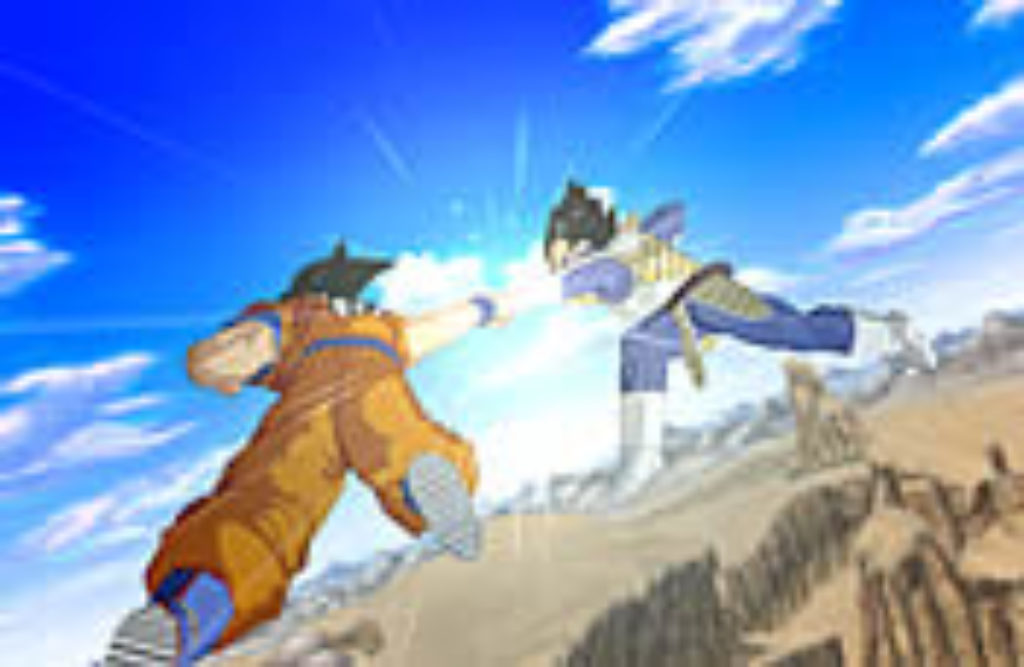
The newest Dragon Ball Z video game has hit the shelves with a robust take that! And fans of the series are happy to see it land for the first time on both the Xbox 360 and PlayStation 3. But just in case you’ve been plugging your ears whenever the subject of manga (or Japanese comics) comes up around the water cooler, let me start out with a brief primer about this series:
Dragon Ball started out in Japan in the early 1980s as a weekly comic that told the tale of Goku, a monkey-tailed boy (yes, I said monkey-tailed) who sets out on a quest to find seven magical dragon balls. Along the way, he meets and trains with many powerful martial artists. The printed story followed Goku’s life into old age and eventually entertained readers around the world.
But the cartoon pages were only the launching point for the Dragon Ball multibillion-dollar international empire. Almost a quarter-century after its introduction, the story has been translated into dozens of languages (including French, Spanish, Chinese and English) and adapted into 42 graphic novels, three successful high-action anime (cartoon) television series, three TV specials, 17 feature films, a collectable trading card game and over 40 different video games. Phew.
Burst Brawl
This particular title, Dragon Ball Z: Burst Limit, throws fanboys and newbies into the latter part of the Dragon Ball timeline. Not that it matters all that much where you land. If you don’t already know the tale inside and out you’re not going to have a clue about what’s going on. The game’s Z-Chronicles Story Mode takes players through three of the dragon ball-seeking sagas, and each contains a jumble of cutscenes featuring bizarre, hyper-muscular, levitating human scrappers, otherworldly aliens who shoot beams from their foreheads and strange little self-cloning androids. On the surface, none of them seem to have any relation to one another, other than wanting to bash everybody else senseless.
And indeed, this is a fighting game, not a fantastical bedtime story that’s supposed to wrap up neatly at the end. Play starts with three combatants and a lengthy tutorial section that gives players a good idea of the many attacks and blocks that can be accessed through the controller’s buttons, bumpers and analog sticks. The insane-looking mid-air tumbles, feints and powerhouse blows can be a bit daunting to keep track of at first swing, but they soon play out as a button-masher’s dream. The key to a decent bad-guy trouncing really comes down to the skillful timing of your button punching rather than memorizing complicated combos.
In addition, players are offered a Trial Mode designed to strengthen those varied skills. For instance, one trial times how quickly you can cut your way through 10 different opponents, while another pits you against a gauntlet of 100 foes and challenges you to keep your character standing (or floating) till the end.
16 Down, 63 Battles to Go
Once you’re feeling unbeatable, it’s off to the Z-Chronicles fray. With each victory—which sends your opponent hurtling to the earth below like a battered meteor—you gain new characters to play (up to a colorful army of 21), fresh attacks, unique battle stages to fight in and special helps called drama pieces. These drama pieces are actually one of the more interesting parts of the battle equation and give the game much more of the anime series action than you would normally get a chance to see in a stock fighter.
These special pieces are essentially brief unlockable cutscenes that depict such things as a teammate rushing in to offer a much-needed life boost, or someone stepping up just in time to help deflect an opponent’s worrisome mental blast. When preparing for battle, gamers can customize their fighter with three of these animated drama pieces to bail them out when the going gets tough.
From there you just keep dodging and swinging at increasingly difficult fighters until you’ve made it through 79 total battles—or your fingers cramp. Before my digits were rendered completely immobile, though, I noticed that while one character does wield a sword and some “die” in non-play cutscenes, the smackdowns remain blood- and gore-free.
A Quarter-Century of Build-Up
Trash talk, however, flows freely. Opponents are constantly attempting to cut you down to size with taunts if they can’t hit you with their fists and feet. The profanity “d–n” shows up two or three times in cutscenes as well as banzai hollers of things such as, “You stupid pipsqueak,” “Now you’ve gone and done it, scum!” “Maggot,” “I’m going to wipe that ugly grin right off your hideous face,” “I’m the devil himself” and “Darn it!”
Eastern spirituality is another uppercut seeking out fresh targets. It’s subtle and hidden under the layers of broad fantasy, but it’s there in the form of focused spirit beams, levitating battles and the quest for magically charged dragon balls—derived originally by series creator Akira Toriyama from a Chinese legend about a spiritual journey called The Monkey King.
So what’s the culmination of 25 years of Dragon Ball lore combined with hyperactive marketing? A highly repetitive game with brightly colored creatures bouncing around a high-def screen in arm-flexing, teeth-gnashing, insult-spitting, laser bolt-blazing mayhem. It may not be as gritty or messy as some video game fighters out there, but magic-laced fantasy violence can still pack a few punches that you may not expect from a cartoon.

After spending more than two decades touring, directing, writing and producing for Christian theater and radio (most recently for Adventures in Odyssey, which he still contributes to), Bob joined the Plugged In staff to help us focus more heavily on video games. He is also one of our primary movie reviewers.